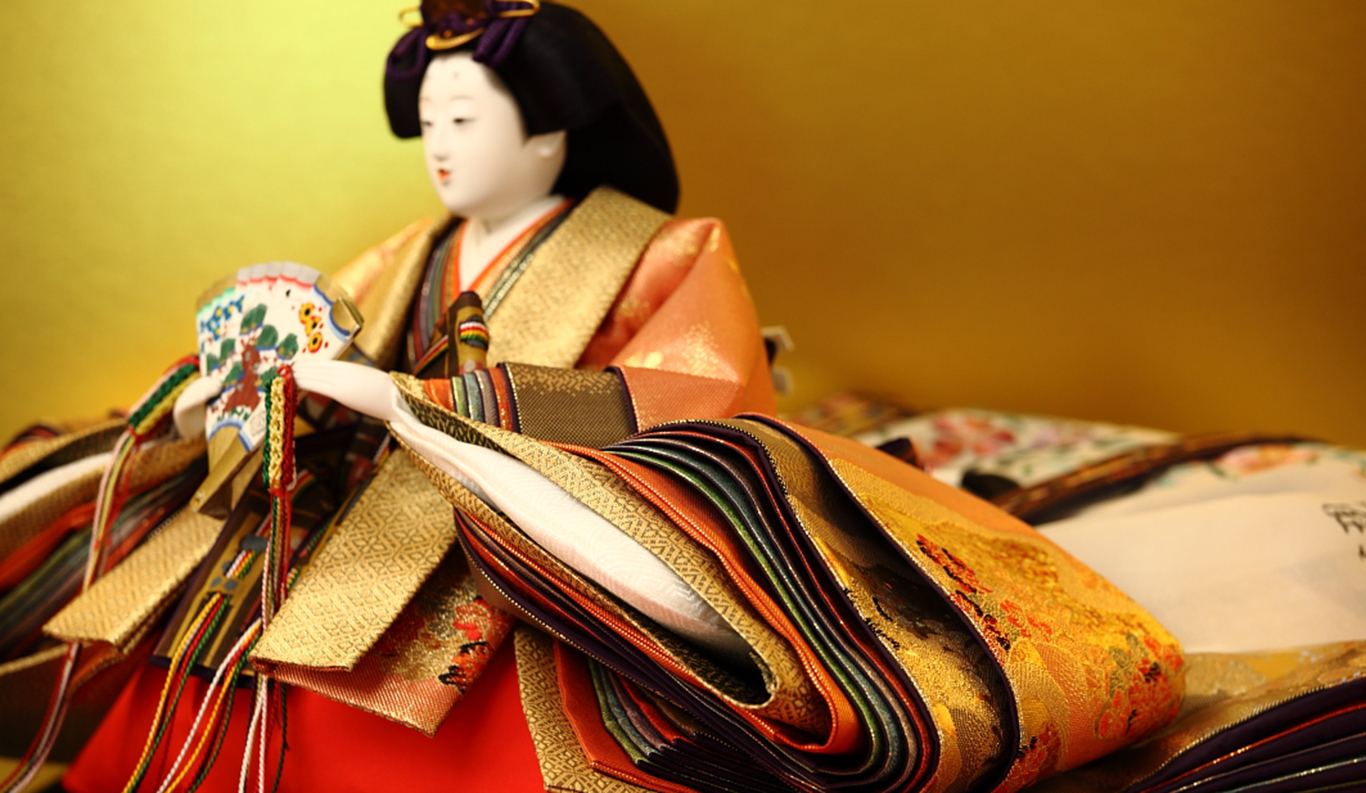Meet with artisans, KYOTO
2 Days 1 Night
2 Days 1 Night
- Day 1
- Kyoto
You will be met by your guide in the ryokan lobby and depart on the “Meet with artisans” tour in Kyoto.
Visit Watabun Orinasu house (museum) and then the work studio. Nishijin-ori woven textiles have long been widely used in the production of kimono and obi sashes, and Nishijin-ori is designated as one of Japan's traditional crafts. This small museum shows the visitor all about dyeing and weaving culture and also Kyoto's industrial arts culture, with a focus on hand weaving. Materials and examples of work are exhibited in the old traditional Kyoto house. You can visit and meet a designated craftsperson in the work studio and then the staff will lead us to see how weaving a single bolt of kimono fabric takes a tremendous amount of time. It is because of such superb workmanship that Nishijin-ori continues to flourish as a mainstream traditional textile craft to the present day.
Visit a craftsman (or craftswoman), at Mr. and Mrs. Nagakusa's embroidery atelier.
Embroidery is the art of decorating fabrics with designs stitched in thread or yarn using a needle. Since the art of embroidery was introduced to Japan from China about 1,600-1,700 years ago, embroidery was the only way to decorate kimono until pattern-dyeing techniques such as yuzen were introduced. The Nagakusas, born in Kyoto, have, since they were married, maintained traditional Kyoto style embroidery and enhanced it to a high artistic level. Mr. Nagakusa has held exhibitions in Paris and has also worked on show window design for Hermes Paris.
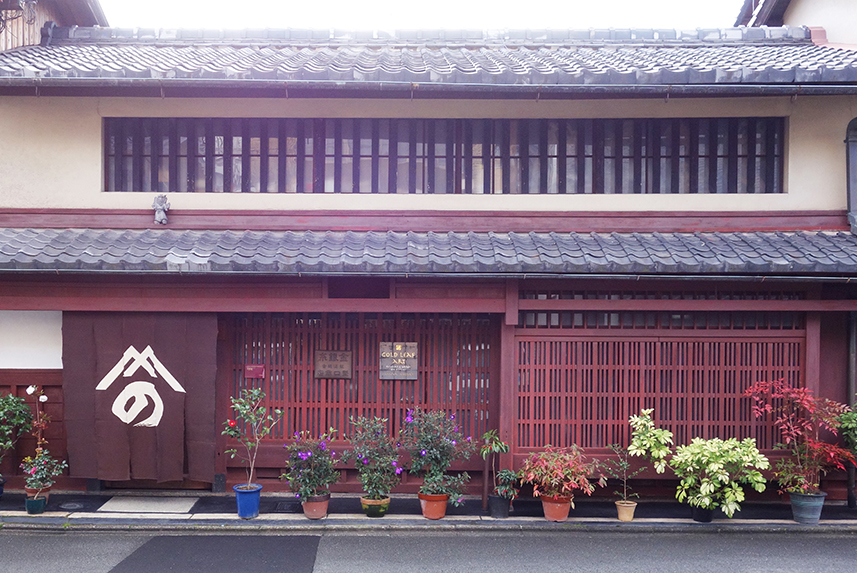
Visit craftsman Mr. Noguchi at a gold-leaf artisan's atelier and his private house.
In this traditional Kyoto house with its beautiful and cozy garden, we can have a look at how one of the preparatory stages – making gold thread for the Nishijin-ori textiles – is done. Mr. Noguchi's great-grandfather started out as a gold thread merchant in around 1877 and now Mr. Noguchi is the 4th generation. The wooden house and garden were built in 1889 and most of them are also well preserved. Some of the art works of Mr. Noguchi and his son are also exhibited.
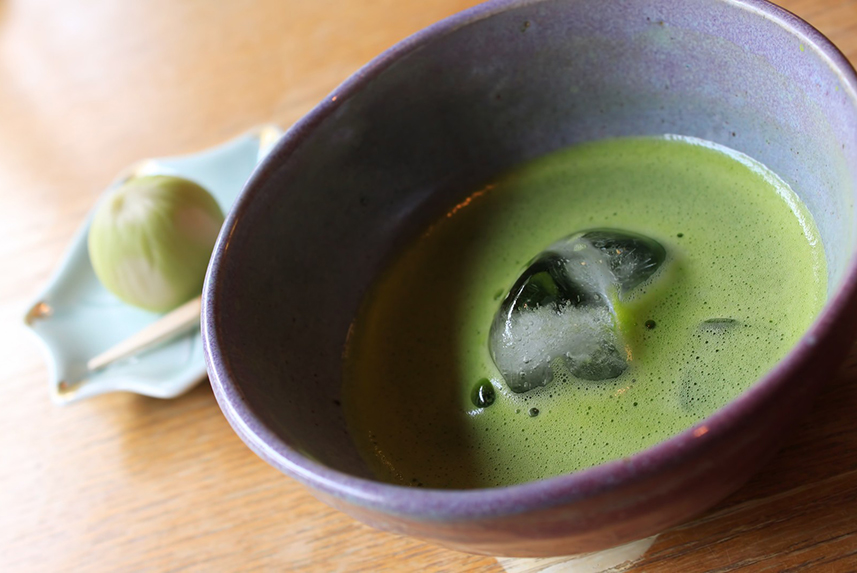
Tea break with wagashi and matcha tea at a Japanese confectioner. A key part of the Cha no Yu ceremony is wagashi, or traditional Japanese confectioneries. Kyoto's tea ceremony culture was particularly influential in the evolution of wagashi. The delicate sweets are made mainly from rice or wheat flour, azuki red beans, and agar-agar, a kind of gelatin made from seaweed. They are skillfully crafted with very subtle flavors so as not to disturb the essence of the carefully chosen matcha tea.
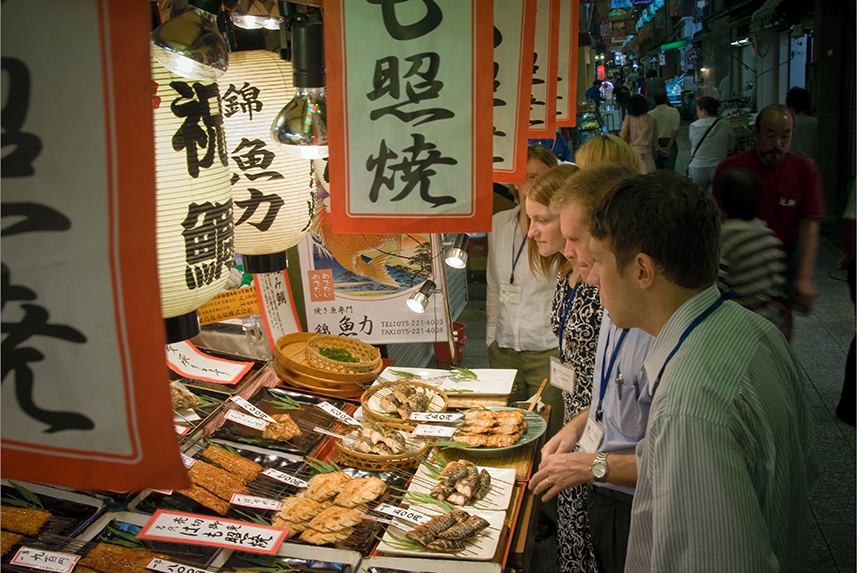
If time allows, stroll Nishiki market. There are about 150 food shops and restaurants along the market's 400-meter length. In this arcade street, we can see several shops featuring the finest Japanese crafts, and we can feel that the Japanese spirit of craftsmanship and the craftsmen's products are still alive and well in local Kyoto people's everyday lives.
You may drop by Aritsugu, which has a name-engraving service for this shop's knives.
Check in at the ryokan in Kyoto. Ryokan Collection has several member ryokan in this area.
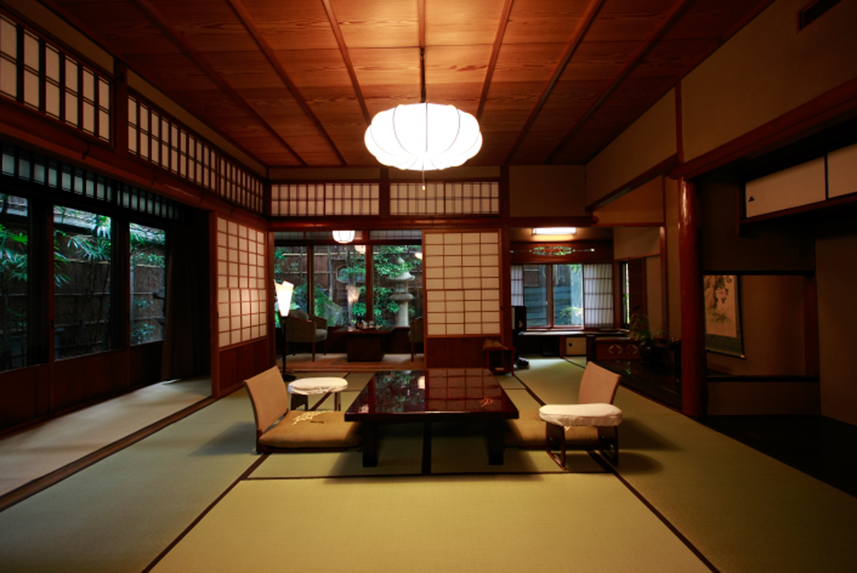
Hiiragiya
Hiiragiya, located in heart of Kyoto, takes great pride in preserving the tradition and culture of Japan. It offers modern-day amenities, without disregarding the aesthetic considerations of the past. Each designed with its own unique motif, the 30 rooms display quintessential Japanese elegance and sophistication. Some rooms feature lacquered bathrooms and others are fitted with marble or tile. Tokens of the past are represented by works of art, such as painted screens or ink paintings. It really is like stepping back in time.
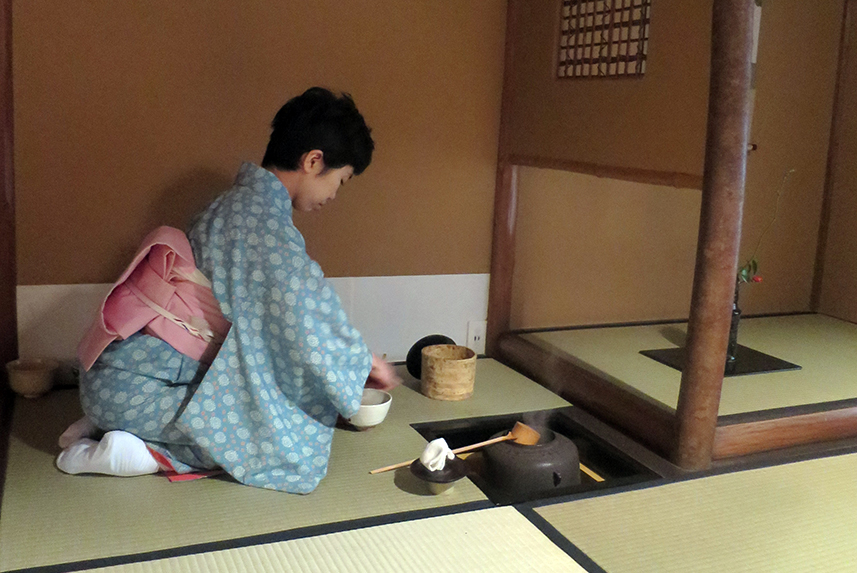
Sumiya
Sumiya is an excellent choice when planning a trip to Kyoto. Located near the heart of the main sightseeing areas, Sumiya is a very authentic style ryokan and has been in business for 100 years. It has seen three generations of owners. Sumiya is offering a new experience for its guests - a chance to experience making, serving and drinking Japanese tea. This service offers a look into the fascinating world of "O-cha" Japanese tea, and the techniques, considerations and customs that enhance its enjoyment. This experience is sure to help deepen your enjoyment and appreciation of the wonderful world of tea.
Visit Watabun Orinasu house (museum) and then the work studio. Nishijin-ori woven textiles have long been widely used in the production of kimono and obi sashes, and Nishijin-ori is designated as one of Japan's traditional crafts. This small museum shows the visitor all about dyeing and weaving culture and also Kyoto's industrial arts culture, with a focus on hand weaving. Materials and examples of work are exhibited in the old traditional Kyoto house. You can visit and meet a designated craftsperson in the work studio and then the staff will lead us to see how weaving a single bolt of kimono fabric takes a tremendous amount of time. It is because of such superb workmanship that Nishijin-ori continues to flourish as a mainstream traditional textile craft to the present day.
Visit a craftsman (or craftswoman), at Mr. and Mrs. Nagakusa's embroidery atelier.
Embroidery is the art of decorating fabrics with designs stitched in thread or yarn using a needle. Since the art of embroidery was introduced to Japan from China about 1,600-1,700 years ago, embroidery was the only way to decorate kimono until pattern-dyeing techniques such as yuzen were introduced. The Nagakusas, born in Kyoto, have, since they were married, maintained traditional Kyoto style embroidery and enhanced it to a high artistic level. Mr. Nagakusa has held exhibitions in Paris and has also worked on show window design for Hermes Paris.

Visit craftsman Mr. Noguchi at a gold-leaf artisan's atelier and his private house.
In this traditional Kyoto house with its beautiful and cozy garden, we can have a look at how one of the preparatory stages – making gold thread for the Nishijin-ori textiles – is done. Mr. Noguchi's great-grandfather started out as a gold thread merchant in around 1877 and now Mr. Noguchi is the 4th generation. The wooden house and garden were built in 1889 and most of them are also well preserved. Some of the art works of Mr. Noguchi and his son are also exhibited.

Tea break with wagashi and matcha tea at a Japanese confectioner. A key part of the Cha no Yu ceremony is wagashi, or traditional Japanese confectioneries. Kyoto's tea ceremony culture was particularly influential in the evolution of wagashi. The delicate sweets are made mainly from rice or wheat flour, azuki red beans, and agar-agar, a kind of gelatin made from seaweed. They are skillfully crafted with very subtle flavors so as not to disturb the essence of the carefully chosen matcha tea.

If time allows, stroll Nishiki market. There are about 150 food shops and restaurants along the market's 400-meter length. In this arcade street, we can see several shops featuring the finest Japanese crafts, and we can feel that the Japanese spirit of craftsmanship and the craftsmen's products are still alive and well in local Kyoto people's everyday lives.
You may drop by Aritsugu, which has a name-engraving service for this shop's knives.
Check in at the ryokan in Kyoto. Ryokan Collection has several member ryokan in this area.

Hiiragiya
Hiiragiya, located in heart of Kyoto, takes great pride in preserving the tradition and culture of Japan. It offers modern-day amenities, without disregarding the aesthetic considerations of the past. Each designed with its own unique motif, the 30 rooms display quintessential Japanese elegance and sophistication. Some rooms feature lacquered bathrooms and others are fitted with marble or tile. Tokens of the past are represented by works of art, such as painted screens or ink paintings. It really is like stepping back in time.

Sumiya
Sumiya is an excellent choice when planning a trip to Kyoto. Located near the heart of the main sightseeing areas, Sumiya is a very authentic style ryokan and has been in business for 100 years. It has seen three generations of owners. Sumiya is offering a new experience for its guests - a chance to experience making, serving and drinking Japanese tea. This service offers a look into the fascinating world of "O-cha" Japanese tea, and the techniques, considerations and customs that enhance its enjoyment. This experience is sure to help deepen your enjoyment and appreciation of the wonderful world of tea.
- Day 2
- Kyoto
Check out from the ryokan.
Leave your luggage at the ryokan and spend the day for sightseeing.
You will be met by your guide in the ryokan lobby.
Visit Rakushien, a Kiyomizu ceramics shop. Continue to Kaikado, a Japanese tea caddy maker that was established in 1875, just after Japan opened its doors to the world. At that time, tinplate was imported from England and the tin was considered a fashionable foreign-made item. The founder of Kaikado, Kiyosuke, first designed the tin tea caddy and he made it into a commercially available foreign-made item. Tea caddies (chazutsu or containers) include double-walled construction to guarantee airtightness and protect the tea leaves from humidity while helping them maintain their aroma. In addition to being used for storing Japanese tea leaves, the caddies are used to hold a wide variety of foodstuffs. They can be also used to store English and Chinese tea, as well as coffee, spices and grains.
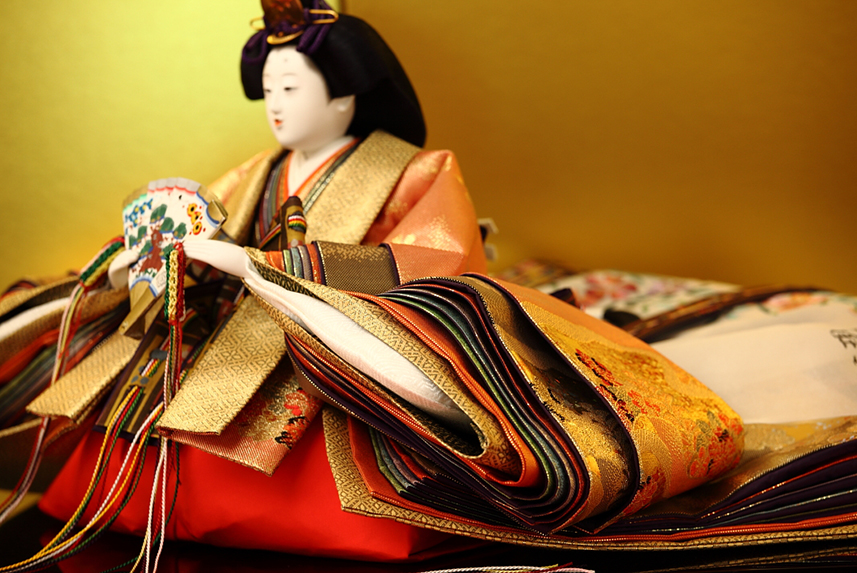
Visit Ando Doll Shop, a traditional Hina doll maker. In Japan, dolls wearing traditional kimono are displayed to pray for the happiness of girls on Hinamatsuri, the Girls' Festival on March 3rd. Ando Doll Shop has passed down the traditional techniques of Hina doll-making for over 100 years. Their dolls are characterised by the rich volume of cloth applied in the making of the dolls' costumes. In particular, the Kyoto-style Hina dolls are charming as their color-matching sense expresses a fine blending of traditional colors, which is highly appreciated and loved by the masters of tea ceremony and ikebana.
Next stop will be Seikado, established in 1838 and Japan's oldest pewter shop.
Return to the ryokan to pick up your luggage and transfer to Kyoto station.
Leave your luggage at the ryokan and spend the day for sightseeing.
You will be met by your guide in the ryokan lobby.
Visit Rakushien, a Kiyomizu ceramics shop. Continue to Kaikado, a Japanese tea caddy maker that was established in 1875, just after Japan opened its doors to the world. At that time, tinplate was imported from England and the tin was considered a fashionable foreign-made item. The founder of Kaikado, Kiyosuke, first designed the tin tea caddy and he made it into a commercially available foreign-made item. Tea caddies (chazutsu or containers) include double-walled construction to guarantee airtightness and protect the tea leaves from humidity while helping them maintain their aroma. In addition to being used for storing Japanese tea leaves, the caddies are used to hold a wide variety of foodstuffs. They can be also used to store English and Chinese tea, as well as coffee, spices and grains.

Visit Ando Doll Shop, a traditional Hina doll maker. In Japan, dolls wearing traditional kimono are displayed to pray for the happiness of girls on Hinamatsuri, the Girls' Festival on March 3rd. Ando Doll Shop has passed down the traditional techniques of Hina doll-making for over 100 years. Their dolls are characterised by the rich volume of cloth applied in the making of the dolls' costumes. In particular, the Kyoto-style Hina dolls are charming as their color-matching sense expresses a fine blending of traditional colors, which is highly appreciated and loved by the masters of tea ceremony and ikebana.
Next stop will be Seikado, established in 1838 and Japan's oldest pewter shop.
Return to the ryokan to pick up your luggage and transfer to Kyoto station.



